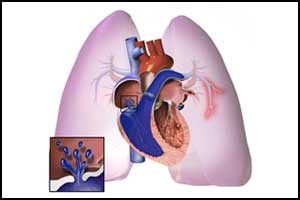- Home
- Editorial
- News
- Practice Guidelines
- Anesthesiology Guidelines
- Cancer Guidelines
- Cardiac Sciences Guidelines
- Critical Care Guidelines
- Dentistry Guidelines
- Dermatology Guidelines
- Diabetes and Endo Guidelines
- Diagnostics Guidelines
- ENT Guidelines
- Featured Practice Guidelines
- Gastroenterology Guidelines
- Geriatrics Guidelines
- Medicine Guidelines
- Nephrology Guidelines
- Neurosciences Guidelines
- Obs and Gynae Guidelines
- Ophthalmology Guidelines
- Orthopaedics Guidelines
- Paediatrics Guidelines
- Psychiatry Guidelines
- Pulmonology Guidelines
- Radiology Guidelines
- Surgery Guidelines
- Urology Guidelines
25% patients have residual pulmonary hypertension after Pulmonary endarterectomy

Pulmonary endarterectomy (PEA) is the standard treatment for chronic thromboembolic pulmonary hypertension (CTEPH), but the surgery leaves 25% of patients with residual pulmonary hypertension (RPH), according to a study published in the Journal of Thoracic and Cardiovascular Surgery.
Pulmonary endarterectomy is a surgical treatment for CTEPH. Although pulmonary endarterectomy is the treatment of choice in terms of both functional outcomes and survival, many patients experience persistent pulmonary hypertension after pulmonary endarterectomy.
Hsieh WC et al conducted a study to calculate the pooled estimates of outcomes after pulmonary endarterectomy including persistent pulmonary hypertension (PPH).
The authors conducted a meta-analysis of published studies reporting residual/persistent/recurrent pulmonary hypertension in 4868 patients with CTEPH after pulmonary endarterectomy. The outcome was the rate of PPH and change in mean pulmonary artery pressure, pulmonary vascular resistance, and 6-minute walk distance after pulmonary endarterectomy.
The analysis revealed that :
- RPH was diagnosed in 25% (95% CI, 0.18-0.34) of PEA-treated patients with CTEPH.
- PEA lowered mean pulmonary artery pressure by 21.42 mmHg (standardized mean difference, 1.75).
- PEA lowered mean pulmonary vascular resistance by 560.3 dyn.s/cm5(standardized mean difference, 1.64).
- PEA increased 6-minute walk distance by a mean of 95.7 m
The study concluded that pulmonary endarterectomy is the standard of care for chronic thromboembolic pulmonary hypertension and provides immediate correction of hemodynamic parameters in most patients.
However, in up to 25% of operable cases, pulmonary hypertension persists after surgery. In those patients with persistent pulmonary hypertension, continued medical management with newer agents may be required to improve pulmonary hemodynamics and patient outcomes.
CTEPH is a long-term disease caused by a blockage in the blood vessels that deliver blood from the heart to the lungs resulting in increased pressure in these arteries. The blockage either results from a hardened blood clot that is thought to originate from the deep veins of the body (thromboembolism) and remains in the arteries, or from a scar that forms at the site where the clot has damaged the arteries, causing permanent fibrous obstruction (blood flow blockage).
For more reference log on to http://10.1016/j.jtcvs.2018.04.110

Disclaimer: This site is primarily intended for healthcare professionals. Any content/information on this website does not replace the advice of medical and/or health professionals and should not be construed as medical/diagnostic advice/endorsement or prescription. Use of this site is subject to our terms of use, privacy policy, advertisement policy. © 2020 Minerva Medical Treatment Pvt Ltd